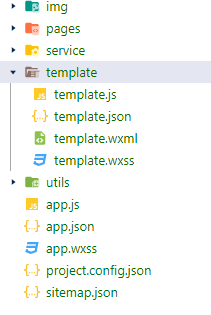最近做的项目有个需求,在点击tabbar的“我的”模块时候,要获取到用户的基本信息,比如用户头像。
按照小程序获取用户信息的方式为:
<button type="getUserInof">按钮</button>但是,在这里,没有途径点击这个按钮。
所以想到自定义tabbar.
一、在文件根目录新建一个template的文件夹,里面新建对应的template的文件。
文件目录如下图:

- template.wxml部分:
<!--pages/template/template.wxml--> <template name="tabBar"> <view class="tabBar"> <block wx:for="{{tabBar}}" wx:for-item="item" wx:key="tabBar"> <view class="tabBar-item"> <navigator open-type="reLaunch" url="{{item.pagePath}}" wx:if="{{item.text!='我的'}}"> <view> <image class="icon" src='{{item.iconPath}}'></image> </view> <view class="{{item.current== 1? 'tabBartext' :''}}">{{item.text}}</view> </navigator> <button open-type="getUserInfo" class="btn_user" bindgetuserinfo="getUserInfo" data-url="{{item.pagePath}}" wx:else> <view> <image class="icon" src='{{item.iconPath}}'></image> </view> <view class="{{item.current== 1? 'tabBartext' :''}}">{{item.text}}</view> </button> </view> </block> </view> </template> - template.wxss部分:
/* pages/template/template.wxss */ .icon{ width:54rpx; height: 54rpx; display: block; margin:0 auto; } .tabBar{ width:100%; position: fixed; bottom:0; padding:10rpx; margin-left:-4rpx; background:#fff; font-size:24rpx; color:#333333; height: 80rpx; z-index: 9999; } .tabBar-item{ float:left; width:20%; text-align: center; overflow: hidden; font-size: 26rpx; } /*当前字体颜色*/ .tabBartext{ color:#CD1811; } .btn_user{ background: transparent; border: none; padding: 0; margin: 0; line-height: normal; position: static; font-size: 26rpx; } button::after{ width: 0; height: 0; } - template.js部分:
function tabbarinit() { return [ { "current": 0, "pagePath": "/pages/index/index", "text":"首页", "iconPath":"/img/tab_indexs.png", "selectedIconPath":"/img/tab_index.png" }, { "current": 0, "pagePath": "/pages/museum/museum", "text":"博物馆", "iconPath":"/img/tab_museums.png", "selectedIconPath":"/img/tab_museum.png" }, { "current": 0, "pagePath":"/pages/mission/mission", "text":"小任务", "iconPath":"/img/tab_missions.png", "selectedIconPath":"/img/tab_mission.png" }, { "current": 0, "pagePath":"/pages/resources/resources", "text":"好资源", "iconPath":"/img/tab_resources.png", "selectedIconPath":"/img/tab_resource.png" }, { "current": 0, "pagePath":"/pages/mine/mines", "text":"我的", "iconPath":"/img/tab_mines.png", "selectedIconPath":"/img/tab_mine.png" } ] } //tabbar 主入口 function tabbarmain(bindName = "tabdata", id, target) { console.log(id,'if') var that = target; var bindData = {}; var otabbar = tabbarinit(); otabbar[id]['iconPath'] = otabbar[id]['selectedIconPath']//换当前的icon otabbar[id]['current'] = 1; bindData[bindName] = otabbar that.setData({ bindData }); } module.exports = { tabbar: tabbarmain }二、在app.wxss引入tabbar的样式:
@import "/template/template.wxss";三、在需要的页面引入文件:
先在js里面引入emplate.js;然后在onload里面定义template
var template = require('../../template/template.js');
Page({
onLoad: function () {
template.tabbar("tabBar", 0, this)//0表示第一个tabbar,根据不同的页面修改序号
},
})然后在wxml里面引入组件,放在所有代码最前边即可。
<import src="../../template/template.wxml"/>
<template is="tabBar" data="{{tabBar:bindData.tabBar}}"/>
<view class="content">
***
</view>这样就完成了自定义tabbar啦。
版权声明:本文为impossible1994727原创文章,遵循CC 4.0 BY-SA版权协议,转载请附上原文出处链接和本声明。